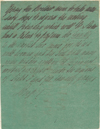Mahatma Letter to H. S. Olcott - LMW 2 No. 20
| Quick Facts | |
|---|---|
| People involved | |
| Written by: | Serapis Bey |
| Received by: | Henry Steel Olcott |
| Sent via: | unknown |
| Dates | |
| Written on: | unknown |
| Received on: | unknown |
| Other dates: | none |
| Places | |
| Sent from: | unknown |
| Received at: | unknown |
| Via: | none |
This is Letter No. 20 in Letters from the Masters of the Wisdom, Second Series. In it Mahatma Serapis Bey advises Henry Steel Olcott about dealing with Helena Petrovna Blavatsky and Emma Hardinge Britten.[1] Letters 9-20 of this series are closely related.
< Prev letter in LMW 2
Next letter in LMW 2 >
< Prev letter to Olcott
Next letter to Olcott >
Page 1 transcription, image, and notes
|
I pray thee, Brother mine, to take necessary steps to adjourn the meeting until Saturday which will be. Sister has a labour to perform. Be friendly to the English seer Emma, for she is a noble woman and her Soul hath many gems hidden within it. Begin not without our Sister. Unto the regents of Light I send for thee my prayer.
|
|
NOTES:
|
Page 2
|
On the back of the page, in Latin and Greek: Sub pretextu juris summum jus saepe summa injuria, Frater; suaviter in modo, fortiter in re. Tantaene animis coelestibus aut vere adepti IRAE?
Translation: Under the plea of justice, the greater right often becomes the greater wrong, Brother. Be gentle in manner, resolute in execution. Can heavenly spirits cherish resentment so dire?
|
NOTES:
|
Context and background
Mr. Jinarājadāsa provided this background information on the series of letters numbered 9-20:
The letters which follow, all written by the Master Serapis, deal with certain incidents in the life of H.P.B., of which there has been scarcely any mention. Colonel Olcott describes in Old Diary Leaves the Philadelphia marriage of H.P.B., but evidently he has forgotten the true reason for it, for the account he gives of H.P.B.’s explanation of it differs from that given by the Master S. The man whom H.P.B. married was little better than a workman. He had lately come to America from Tiflis in Russia, and had built up a small business as an importer and exporter. He was sincerely drawn to Spiritualism, and evidently in the beginning was desirous of helping H.P.B. to carry out her great schemes to found a spiritual philosophy. On the strict understanding that his privileges as husband would only consist in making a home for her, so that she might carry out the plan of the Brotherhood, H.P.B. married him, though a woman of her aristocratic nature must have felt intensely humiliated to be linked to such a peasant. There was a stipulation that, even though married, she should retain her own name of Blavatsky. After H.P.B. left him, he obtained a decree of divorce, so that when she started for India, the sad incident of the second marriage was utterly closed...[2]
Physical description of letter
The original of this letter is preserved at the Theosophical Society, Adyar, Chennai, India. Mr. Jinarājadāsa wrote:
Five of the letters of the Master Serapis were received through the post, and their envelopes still remain, and bear the postmark. Four of them were posted in Philadelphia and one in Albany. Colonel Olcott received them in New York at his house, or in Boston care of the Postmaster. Seven of the letters are written on green paper with black ink.[3]
Publication history
This letter was published for the first time in the Second Series of Letters from the Masters of the Wisdom, and then reproduced with a facsimile in Did Madame Blavatsky Forge the Mahatma Letters?[4]
Commentary about this letter
Mr. Jinarājadāsa provided this commentary:
Throughout these letters about H.P.B., there are several references to the “Dweller on the Threshold.” This mysterious phrase occurs in Zanoni. It is evident that challenging the Dweller, and risking one’s very existence in the process, is one of the trials of the Initiate. There is no clue in the letters showing of what type were the dangers which confronted H.P.B., so that her very life was at stake.
These letters to Colonel Olcott from the Master S. mention incidents in H.P.B.’s inner life. As none have a right to peer inquisitely into the workings of the soul, I have omitted all references to such incidents, extracting out of the letters only such teachings as seem to me to have value to earnest students.[5]
Additional resources
Notes
- ↑ C. Jinarājadāsa, Letters from the Masters of the Wisdom, Second Series (Adyar, Madras,India: Theosophical Publishing House, 1925), 43-44.
- ↑ C. Jinarājadāsa, 21.
- ↑ C. Jinarājadāsa, 22.
- ↑ C. Jinarājadāsa, Did Madame Blavatsky Forge the Mahatma Letters? (Adyar, Madras, India: Theosophical Publishing House, 1934), 41.
- ↑ C. Jinarājadāsa, 21-22.

